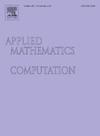验证具有一般系数的稀疏线性系统解的方法
IF 3.5
2区 数学
Q1 MATHEMATICS, APPLIED
引用次数: 0
摘要
本文针对具有一般非奇异系数矩阵的稀疏线性系统 Ax=b 提出了一种验证方法。验证方法可得出给定近似解的误差边界。实用方法有两种。一种方法是利用对称性和正定性来验证正则方程 ATAx=ATb 的计算解;然而,ATA 的条件数是 A 的条件数的平方。此外,还提出了其他几种方法,但由于各种问题,这些方法都被认为是不切实际的。本文利用之前的验证方法和最新的均衡,提供了一种验证误差边界的计算方法。所提出的方法可以减少填充,适用于很多问题。此外,我们还将展示迭代细化法获得精确解的效率。本文章由计算机程序翻译,如有差异,请以英文原文为准。
Method for verifying solutions of sparse linear systems with general coefficients
This paper proposes a verification method for sparse linear systems with general and nonsingular coefficient matrices. A verification method produces the error bound for a given approximate solution. Practical methods use one of two approaches. One approach is to verify the computed solution of the normal equation by exploiting symmetric and positive definiteness; however, the condition number of is the square of that for A. The other approach applies an approximate inverse of A; however, the approximate inverse of A may be dense even if A is sparse. Additionally, several other methods have been proposed; however, they are considered impractical due to various issues. Here, this paper provides a computing method for verified error bounds using the previous verification method and the latest equilibration. The proposed method can reduce the fill-in and is applicable to many problems. Moreover, we will show the efficiency of an iterative refinement method to obtain accurate solutions.
求助全文
通过发布文献求助,成功后即可免费获取论文全文。
去求助
来源期刊
CiteScore
7.90
自引率
10.00%
发文量
755
审稿时长
36 days
期刊介绍:
Applied Mathematics and Computation addresses work at the interface between applied mathematics, numerical computation, and applications of systems – oriented ideas to the physical, biological, social, and behavioral sciences, and emphasizes papers of a computational nature focusing on new algorithms, their analysis and numerical results.
In addition to presenting research papers, Applied Mathematics and Computation publishes review articles and single–topics issues.

 求助内容:
求助内容: 应助结果提醒方式:
应助结果提醒方式:


